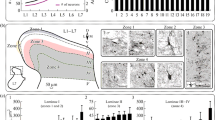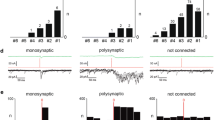Abstract
The central projections of specific subpopulations of lumbar primary afferents were selectively labeled with the lipophilic tracer DiI in fixed preparations of the chicken embryo. Muscle or cutaneous afferents were selectively labeled by applying DiI to identified peripheral nerves. Medial or lateral afferent populations were selectively labeled by partially lesioning the dorsal root. Muscle and cutaneous afferent populations each contribute to both the medial and the lateral afferent populations. Medial muscle afferents terminate in the intermediate zone and lateral motor column proximally, but only in the intermediate zone distally. Lateral muscle afferents terminate in a ventrolateral region of the dorsal horn both proximally and distally. Medial cutaneous afferents terminate predominantly in lamina III, but a few terminate in the medial region of the intermediate zone. Lateral cutaneous afferents terminate in lamina II and in a ventrolateral region of the dorsal horn. On the basis of the principle termination patterns, specific termination fields were defined and related to the classical cytoarchitectonics of the spinal gray matter. Differential retrograde tracing from the spinal cord with fluorescent dextran-amines demonstrated that the medial afferents originate from the earlier-generated ventrolateral population of large sensory cell bodies, while the lateral afferents originate from the later-generated dorsomedial population of small sensory cell bodies. The medial afferents establish their central projections earlier than the lateral afferents, but for each subpopulation the initial pattern of termination prefigures the mature pattern, throughout the segmental range of the collaterals. Birthdating with 3H-thymidine showed that potential target neurons in the different terminal fields within the dorsal horn are born at different times. In particular, interneurons in lamina II are born after those in lamina III, paralleling the early and late termination of cutaneous afferents in these laminae. Our observations support the notion that primary afferents recognize specific cues in the spinal cord, but also implicate the relative timing of afferent and target differentiation as an important determinant of primary afferent termination patterns.
Similar content being viewed by others
Author information
Authors and Affiliations
Additional information
Accepted: 30 July 1996
Rights and permissions
About this article
Cite this article
Eide, A., Glover, J. Developmental dynamics of functionally specific primary sensory afferent projections in the chicken embryo. Anat Embryol 195, 237–250 (1997). https://doi.org/10.1007/s004290050043
Issue Date:
DOI: https://doi.org/10.1007/s004290050043




